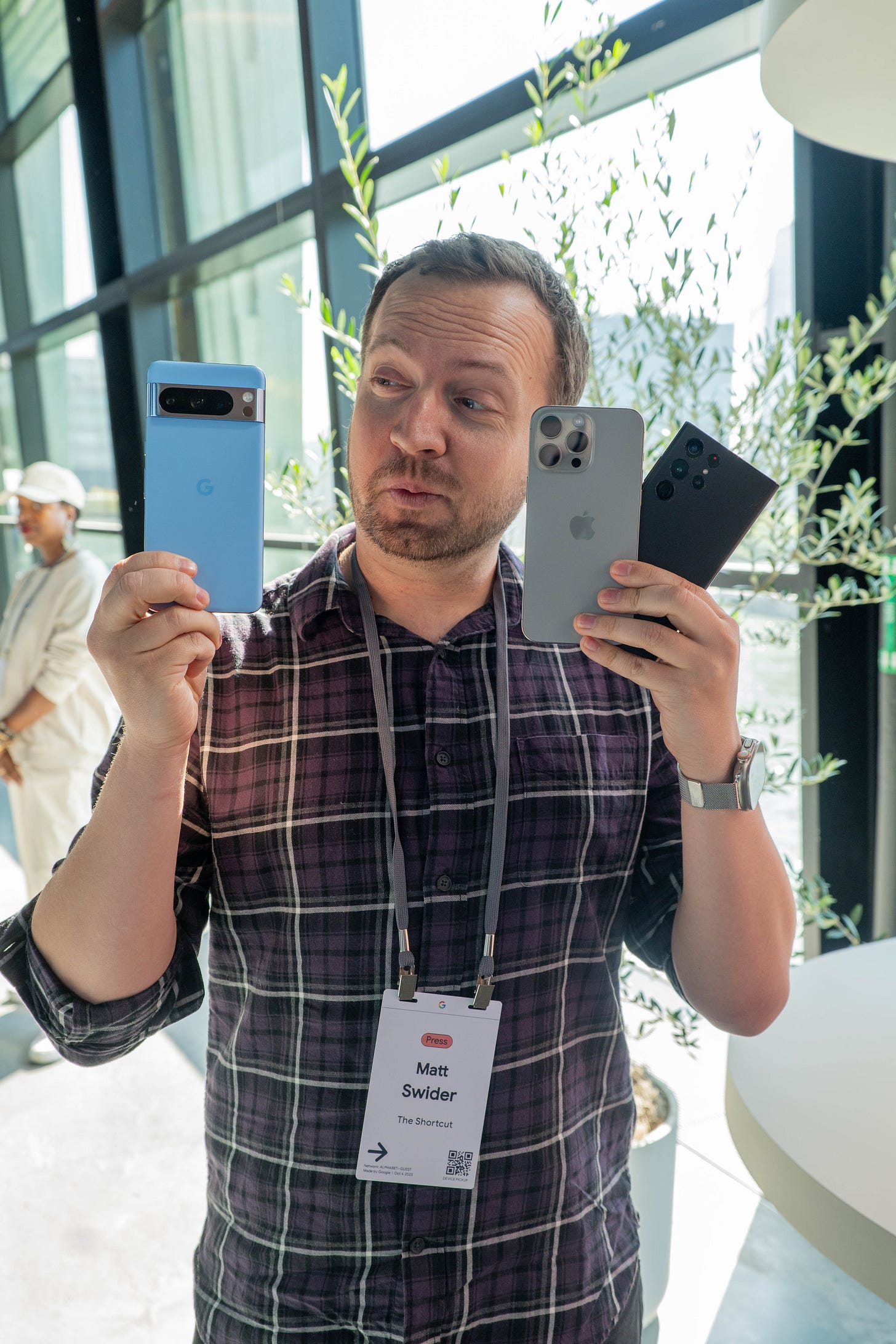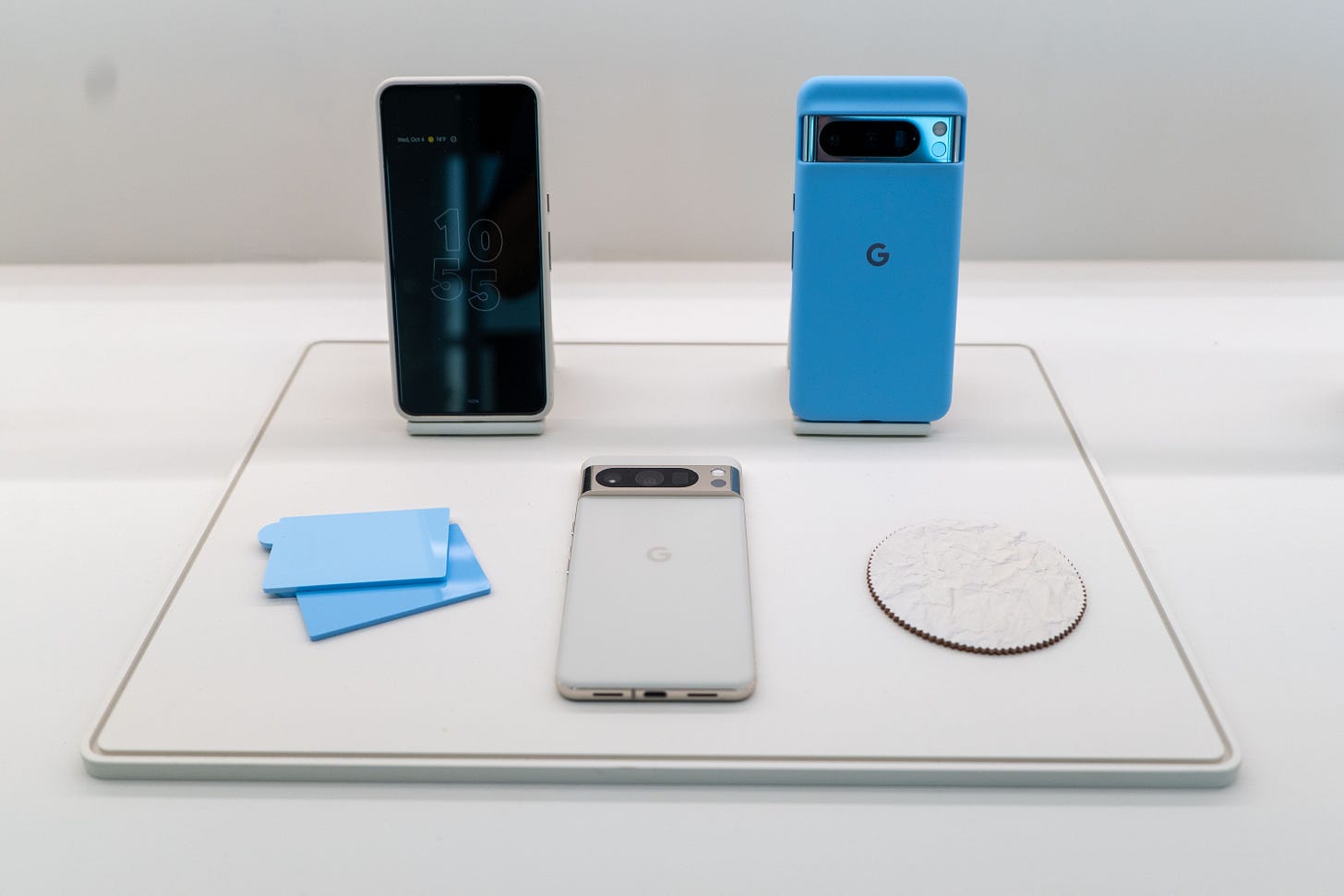Google Pixel 8 and 8 Pro hands-on review: an AI camera that can magically fix your bad photos
There's one big reason to buy a Google Pixel 8 phone this year
Here’s the basic pitch for the new Google Pixel 8 and Pixel 8 Pro: you can finally fix your bad photos thanks to AI wizardry – but you’ll have to pay $100 more for this year’s Android phones. Worth it?
It’s happened to us all: you look good in the first shot where not everyone is looking at the camera, but in the second shot everyone else looks better and you look awful. Well, Google’s “Best Take” feature uses AI to blend the faces of a series of photos into a single perfect picture, and “Magic Editor” lets you further reframe and refine it.
The $699 Google Pixel 8 and $999 Pixel 8 Pro polish the design and boost the specs to be mildly interesting otherwise. They have better cameras, brighter displays and faster chipsets. But the AI behind the cameras is the main selling point, even if the actual horsepower of the phones is outclassed by the iPhone 15 Pro Max and the telephoto Google Pixel 8 Pro’s camera doesn’t zoom as far as the Samsung Galaxy S23 Ultra.
Here’s my ongoing news and analysis. I’ll be followed by a hands-on leading up to a full Google Pixel 8 Pro review.
Why trust my forthcoming Google Pixel 8 review ✅
I’ve reviewed and tested every single Google Pixel phone and, before that, every Google Nexus phone on TechRadar, including the Google Nexus 6 and Google Pixel 3, and then The Shortcut starting with the Pixel 7 and Pixel 7 Pro.
Google Pixel 8 and 8 Pro hands-on review
🤪😃🙄 Face Swap. “I like my face in this photo – but everyone else looks good in the second shot.” Sound familiar? Google’s “Best take” uses AI to fix these common scenarios, blending the best smile, silly face or serious expression into a single photo. It won’t work for pets, but this aggregating shot takes Google’s Top Shot to the next level. I’ll be testing it out more in my full Google Pixel 8 Pro review.
Here are the best example of “Best Take” (aka what people are calling Face Swap) in action on the Google Pixel 8:
✂️ Magic Editor reimagines photos. Reposition and resize subjects, reframe photos, take out objects and adjust lighting positioning – all with the Pixel 8 series’ generative AI. Yes, Photoshop can do this now, too, but having it built right into the camera feels like a game changer if you’re willing to manipulate photos beyond simple fine tweaks.
📸 Cameras let in more light. This year’s cameras have been souped-up to let in more light for better night shots – the biggest Pixel camera upgrade since Pixel 6.
📸 Main camera: Same 50MP as the 7 series, but lets in 21% more light than the thanks to an improved f/1.6 aperture. Night shots will look better.
👐 Ultra-wide camera. New 48MP (Pixel 8 Pro) and 12MP (Pixel 8) cameras with auto-focused for macro shots and up to 105% more light vs the Pixel 7 series. Also has a wider field of view.
🔭 Telephoto camera: 48MP with 5x optical and 30x digital zooms. It lets in 56% more light vs the Pixel 7 Pro. No telephoto camera on the Pixel 8.
🤳 Selfie camera: 10.5MP with the new perk being auto-focused on the Pixel 8 Pro. The Pixel 8 is still limited to a fixed focus.
🎛️ Pro controls for Pixel 8 Pro. If you want more control over your photos, you’ll have to opt for the Google Pixel 8 Pro, which allows you to tinker with the focus, shutter speed and more. It’ll also let you access full 50MP images as JPEGs or RAW.
🪨 Stronger glass on the Pixel 8 Pro. Corning Gorilla Glass Victus 2 represents an upgrade over the Pixel 7 Pro, leaving the regular Pixel 8 with Corning Gorilla Glass Victus. I first tested Gorilla Glass Victus 2 on the Galaxy S23 Ultra, and it’s faired really well since February after some unintentional drops.
📐 Slightly smaller Pixel 8 size. The design hasn’t changed much, but the Pixel 8 has gotten a fraction of an inch smaller. Its 6.2-inch display fits in between the 6.3-inch Pixel 7 and 6.1-inch Pixel 7a. It’s not extremely noticeable.
📺 Brighter ‘Actua’ screens. It’s a silly name that’s supposed to signify ‘Actual’ according to Google (I guess they didn’t want to take the L). The main benefit I see from this is that the Pixel 8 has a 42% peak brightness increase to 1400 nits, and the Pixel 8 Pro reaches a 2400 nit peak brightness.
🏃♂️ Faster refresh rate. Google bumped up the Pixel 8 screen refresh rate to 60-120Hz (up from 90Hz) and the Pixel 8 Pro to range from 1-120Hz.
🌡️ Object temperature sensing. An odd, but useful feature in the Pixel 8 Pro toolkit: you’ll be able to scan for the temperature of objects. Maybe we’ll put it to the test on the hot iPhone 15. Google did note that it has efficiency improvements to reduce its own heat and keep thermals in check.
😬 Face unlock upgraded. Google is more confident in its Face Unlock technology that it’s trusting the biometrics with app sign-ins, including for banking apps. It says that the upgrade is a mix of software and hardware. We’ll see if anyone can crack it.
⚙️ Tensor G3 chip focuses on AI. Google is focusing on AI perks with its latest chip. I’m going to test this one hard, especially because the competition is fierce. Apple’s A17 Pro chipset has so much horsepower that it can play console-quality games, and Samsung’s use of Qualcomm’s Snapdragon 8 Gen 2 chip has proven plenty fast vs last year’s Google Tensor G2 chip that lagged a bit. Tests incoming.
🗄️ 1TB Pixel 8 Pro exclusive to the US. So far, I’m seeing the biggest storage capacity only available in the US. Expect to pay a premium.
📹 Video boost. Google is using machine learning to stabilize video and brighten footage for the first time with Night Sight for video (coming later).
🎙️ Audio magic eraser in videos. Video sound should also improve, as Google is allowing for ways to remove distracting sounds, wind and crowd noise.
🧠 Google AI features. Google Assistant is always getting smarter, and in addition to having natural conversations with you and understanding speech even if it’s full of pauses and “uhhs,” it’ll actually proofread and fix grammar, punctuation and spelling mistakes in texts.
👴 7 years of OS upgrades. This may be just as surprising as the camera perks. Google is promising that the Pixel 8 series will be getting seven years’ worth of Android upgrades.
Full Google Pixel 8 and 8 Pro specs
📆 Release date: October 12, 2023
💰 Price: $699 / $999
📺 Screen size: 6.2-inch / 6.7-inch
🖥️ Resolution: 2400 x 1080 / 1344 x 2992
🏃♂️ Refresh rate: 60-120Hz / 1-120Hz adaptive
💡 Brightness: 2,000 / 2,400 nits (peak brightness)
📸 Main camera: 50MP
📸 Ultrawide camera: 12MP / 48MP
📸 Telephoto camera: 48MP with 5x optical zoom
🤳 Selfie camera: 10.5MP
⚙️ Chipset: Google Tensor G3
🐏 RAM: 8GB / 12GB
🗄️ Storage: 128 FB / 256GB / 512GB (Pro) / 1TB (Pro)
🔈 Speakers: stereo (and no headphone jack)
🔋 Battery: 4,485mAh / 4950 mAh
🔌 Wired Charging: 30W
⚡ Wireless Charging: Yes, 15W and battery share
📶 Connectivity: 5G sub6 and mmWave, WiFi 7
👁️ Biometrics: Face Unlock, Under-screen fingerprint sensor
⚖️ Weight: 187g / 213g
🌈 Colors (Pixel 8): Obsidian, Hazel, Rose
🌈 Colors (Pixel 8 Pro): Obsidian, Porcelain, Bay
🤖 OS: Android
🪨 Durability (Pixel 8): Corning Gorilla Glass Victus, matte aluminum frame
🪨 Durability (Pixel 8 Pro): Corning Gorilla Glass Victus 2, polished aluminum frame
💦 Waterproof: IP68
















